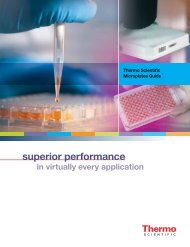PeloBiotech
You also want an ePaper? Increase the reach of your titles
YUMPU automatically turns print PDFs into web optimized ePapers that Google loves.
www.pelobiotech.com<br />
GMP iPS cells<br />
GMP iPSCs are high-quality induced pluripotent stem cells derived from adult tissue biopsies, suitable for therapeutic<br />
applications. They meet strict regulatory standards to ensure their safety and effectiveness for human use.<br />
• We use StemRNA Reprogramming Technology, which is virus-free and complies with regulatory guidelines.<br />
• Benefits include iPSCs manufactured according to ICH 5QA standards, generated with footprint-free RNA<br />
reprogramming technology, and available for commercial use.<br />
• Diverse donors and over 30 years of experience in human tissue procurement.<br />
• StemRNA Reprogramming Technology produces robust iPSCs with low batch-to-batch variation,<br />
eliminating the need for screening exogenous genes.<br />
• Our iPSC seed stocks, Master Cell Banks, and working cell banks are suitable for commercial and therapeutic<br />
applications.<br />
iPS derived cells<br />
We use human iPSC technology, to create a wide range of cell models and biosensor technologies. Our capabilities cater<br />
to various applications, spanning preclinical drug discovery, biobanking, in vitro diagnostics, and biomarker<br />
development.<br />
Induced pluripotent stem (iPS) cells offer several advantages and serve as a superior human disease model compared to<br />
animal cells for several reasons:<br />
• Human Relevance: iPS cells are derived from human tissues, making them more relevant for studying human<br />
diseases. This is crucial because human physiology and disease mechanisms can differ significantly from those<br />
of animals.<br />
• Patient-Specific Modeling: iPS cells can be generated from individual patients, allowing the creation of patientspecific<br />
disease models. This is invaluable for studying genetic diseases and understanding the unique aspects<br />
of a patient's condition.<br />
• Disease Recapitulation: iPS cells can be differentiated into a variety of cell types relevant to the disease being<br />
studied, such as neurons, cardiomyocytes, or hepatocytes. This enables researchers to closely mimic disease<br />
conditions in a dish.<br />
• Genetic Manipulation: iPS cells can be genetically modified to introduce disease-associated mutations or correct<br />
genetic defects. This provides a precise way to investigate the genetic basis of diseases.<br />
• Drug Screening: iPS-derived cells can be used for high-throughput drug screening to identify potential therapies<br />
or test drug efficacy. This is particularly important for personalized medicine.<br />
• Reduced Ethical Concerns: Using iPS cells alleviates many ethical concerns associated with the use of embryonic<br />
stem cells, which can be controversial.<br />
• Consistency: iPS cells provide a consistent and reproducible source of human cells for experimentation,<br />
eliminating genetic variability found in animal models.<br />
• Translation to Clinical Applications: iPS cells have the potential to be used in cell-based therapies and<br />
regenerative medicine, making them a bridge between research and clinical applications.<br />
• Longitudinal Studies: Researchers can derive iPS cells from patients at different stages of a disease and track<br />
the disease progression over time, which is challenging to do with animal models.<br />
• Cost and Time Efficiency: iPS cell-based research is often more cost-effective and less time-consuming than<br />
working with animal models.<br />
The latest applications of induced pluripotent stem cells (iPSCs) encompass a wide array of cutting-edge advancements<br />
in regenerative medicine, disease modeling, drug screening, and cell therapy. These applications have been made possible<br />
by the unique properties of iPSCs, which are similar to embryonic stem cells (ESCs) in terms of morphology, proliferation,<br />
and gene expression profile (Okita & Yamanaka, 2008). iPSC technology has significantly enriched regenerative medicine<br />
by introducing autologous pluripotent progenitor pools bioengineered from ordinary somatic tissue, offering potential in<br />
disease modeling and therapeutic applications (Nelson et al., 2009; Polo et al., 2010). Notably, the first clinical study using<br />
human iPSC-derived cells was initiated in 2014, utilizing human iPSC-derived retinal pigment epithelial (RPE) cells to treat<br />
macular degeneration, resulting in improved vision for the patient (Shi et al., 2016).<br />
Recent advances in differentiating cells such as cardiac, neural, and skeletal muscle cells from iPSCs, as well as directly<br />
reprogramming somatic cells in tissue regeneration applications, have been summarized and synthesized, highlighting the<br />
versatility of iPSCs in various therapeutic contexts (Mao et al., 2022). iPSCs have also been explored for bone<br />
regeneration, cardiovascular disease, and as pre-clinical models for studying human disease, demonstrating their potential<br />
in diverse medical applications (He et al., 2018; Plews et al., 2012; Huang et al., 2020).<br />
9
















